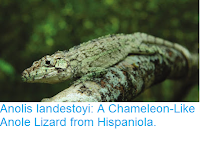Three living and one extinct species of South Pacific Iguana, Brachylophus spp., are known from the islands of Fiji, as well as a single species of a second genus Lapitiguana, a much larger, but also now extinct, Lizard. These Iguana’s are thought to have lived in isolation in the island group for around 40 million years, with their closest living relatives found in the deserts of the southwestern United States. Each species of South Pacific Iguana is recorded only from a single island, but several other islands of Fiji are known to host Iguanas, suggesting that either some of these species have greater ranges than has previously been recorded, or that there are undiscovered species of Iguana in the islands.
In a paper published in the journal Zootaxa on 6 June 2017, Robert Fisher of the San Diego Field Station of the U.S. Geological Survey’s Western Ecological Research Center, Jone Niukula of The National Trust of Fiji, Dick Watling of NatureFiji-MareqetiViti, and Peter Harlow of the Taronga Conservation Society, describe a new species of South Pacific Iguana from Gau Island, Fiji.
The new species is named Brachylophus gau, the Gau Iguana, and is distinguishable from all other members of the genus by the colouration of the throat, which is a plain green in both sexes. The species has a mean snout-vent length (length excluding the tail of 149.2 mm, and a maximum of 153 mm (the total length, including the tail, was not used as several specimens showed signs of having lost and regrown their tails, which will reduce this). These Iguanas are bright green in colour, shading from avocado green on their backs to sulphur green on their bellies, with a series of blue-grey bands on their body and tail.
Illustration of the male, left, and female, right, of Brachylophus gau. The painting is from photographs of these specimens and others from life. Measurements to scale within illustration. The male is missing later 2/3 of tail, but tail drawn here based on photos from other males. Cindy Hitchcock in Fisher et al. (2017).
Although this species had not previously been recorded, examination of museum specimens found two additional examples of this Iguana in the collection of the Natural History Museum in London. These were donated by John MacGillivray of the H.M.S. Herald in 1855, with a recorded location only of ‘Fiji’. Examination of the MacGillivray’s private journal shows that the H.M.S. Herald did indeed visit Gau Island on 12 and 27 September 1854, where MacGillivray shot Green Iguanas hidden in the foliage of the Ivi (Tahitian Chestnut) Tree.
See also...
Follow Sciency Thoughts on Facebook.







